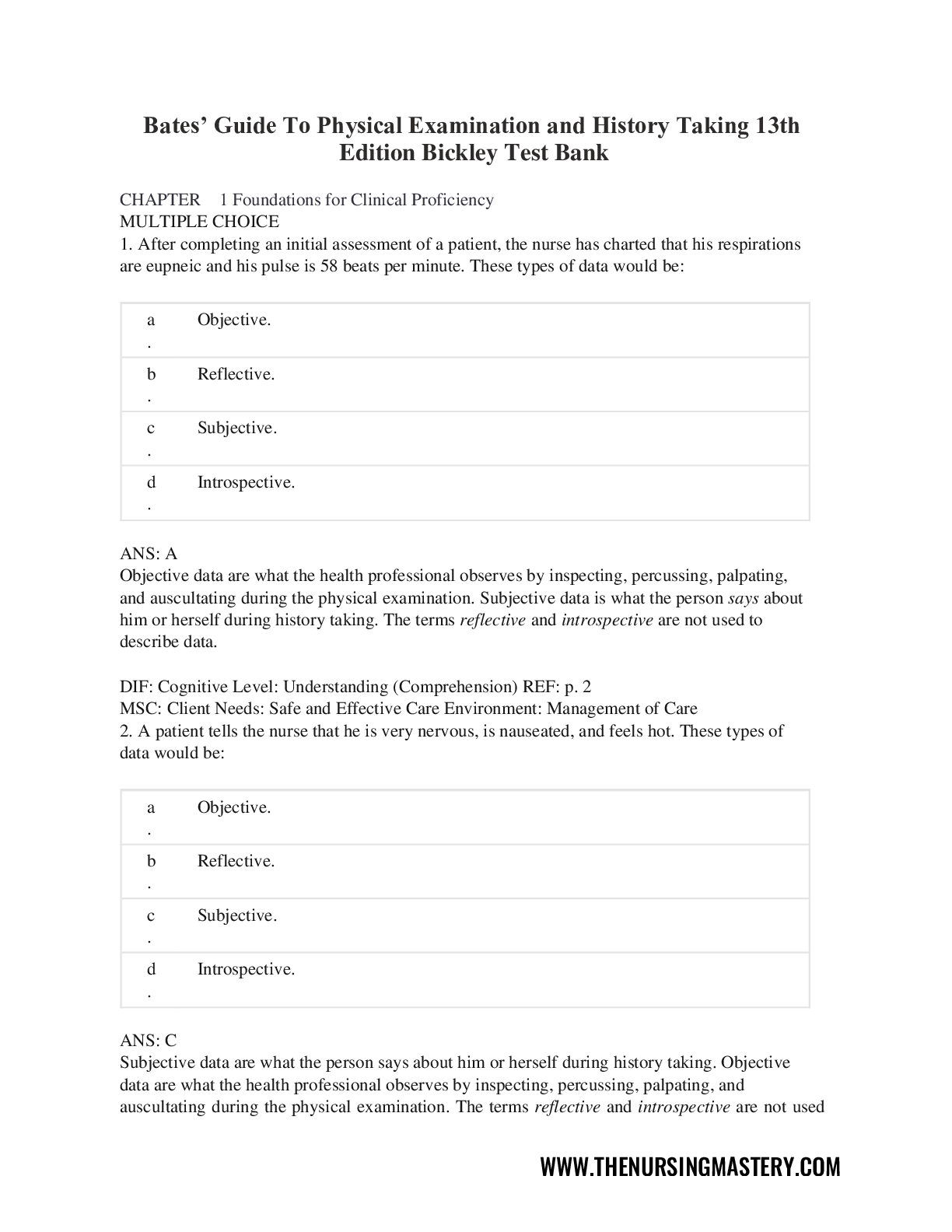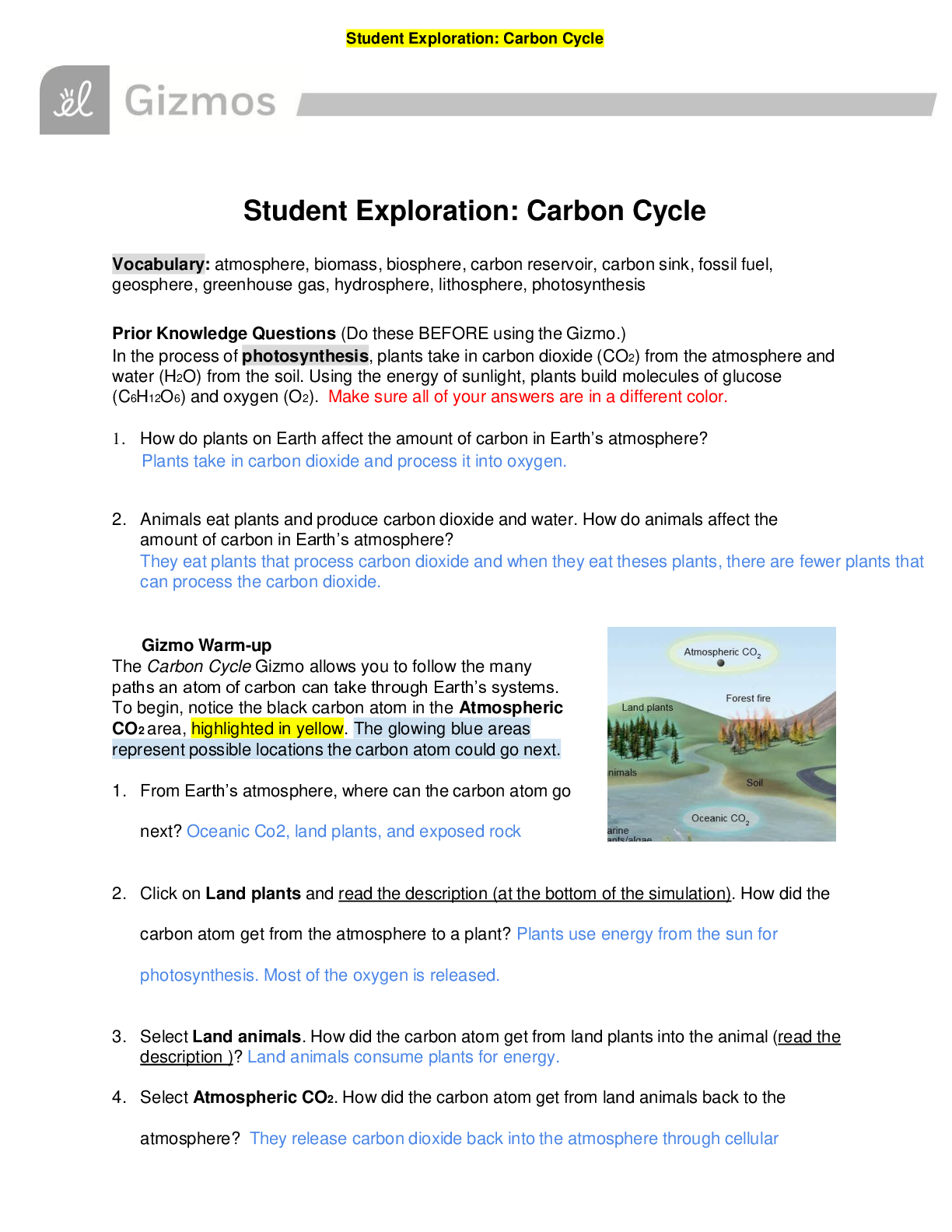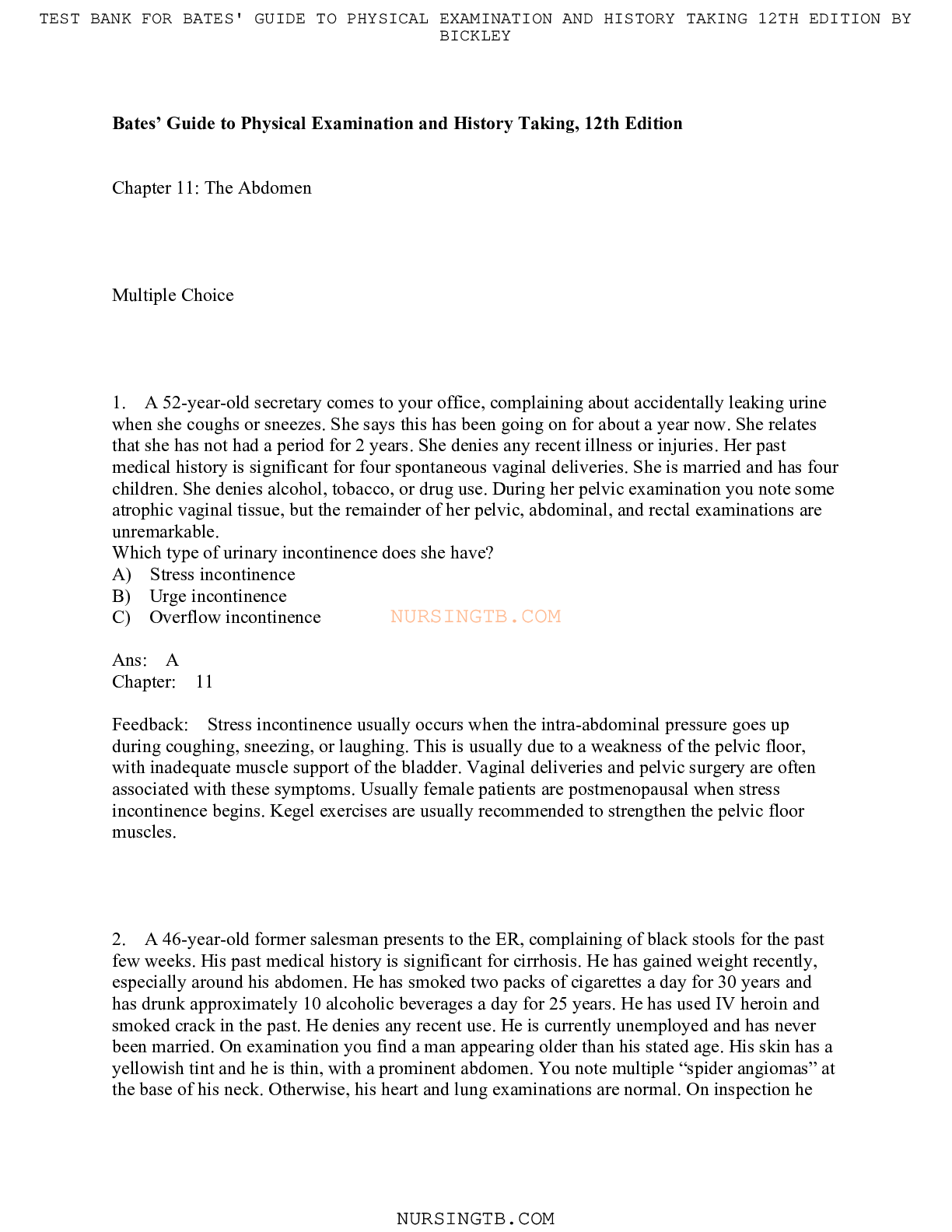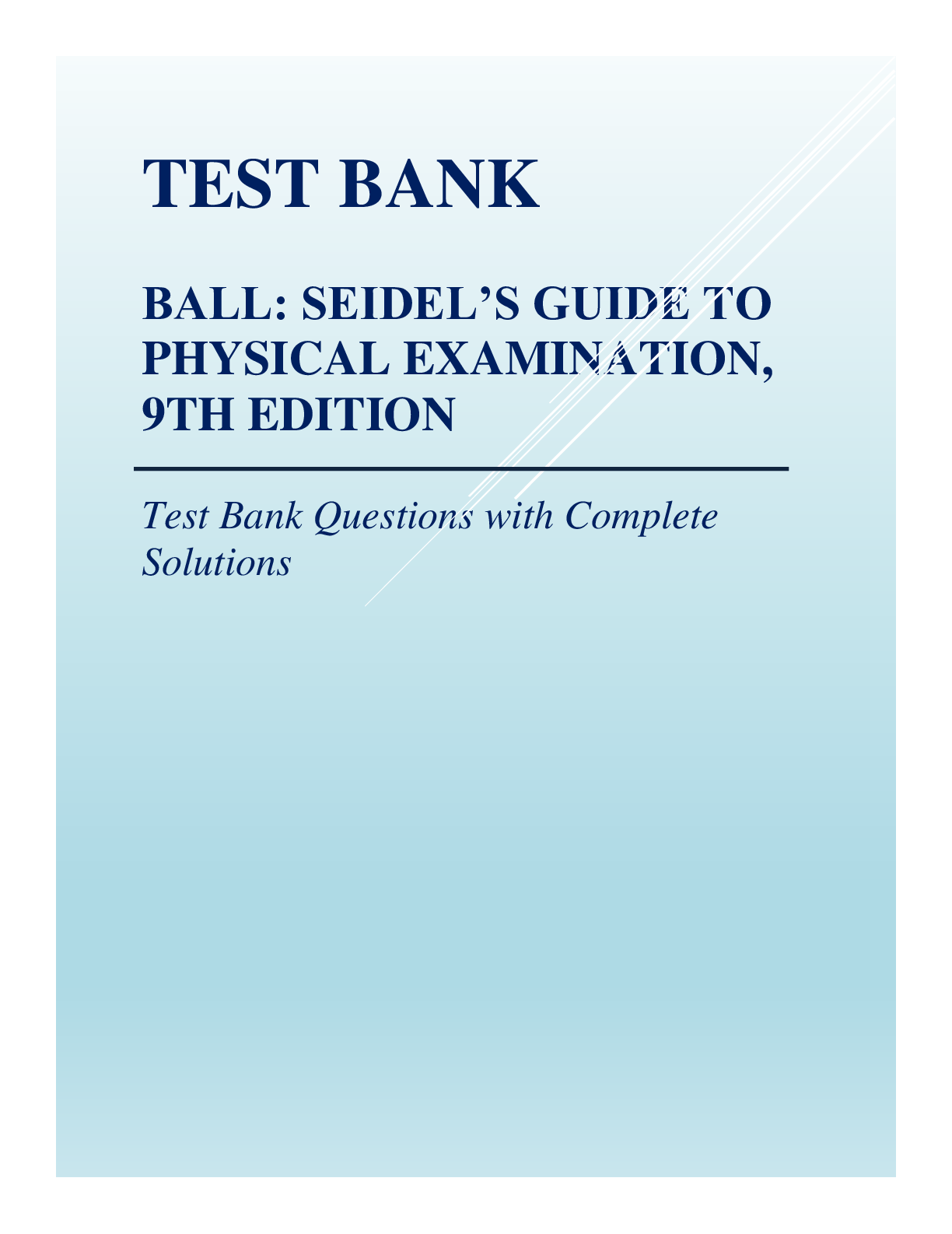*NURSING > QUESTIONS & ANSWERS > Bates’ Guide To Physical Examination and History Taking 13th Edition Bickley Test Bank & Rationals (All)
Bates’ Guide To Physical Examination and History Taking 13th Edition Bickley Test Bank & Rationals (Bates’ Guide To Physical Examination and History Taking 13th Edition Bickley Test Bank & Rationals
Document Content and Description Below
Test Bank Bates’ Guide To Physical Examination and History Taking 13th Edition Bickley Test Bank & Rationals Bates Guide To Physical Examination and History Taking 13th Edition Bickley Test Bank Bat... es Guide To Physical Examination and History Taking 13th Edition Bickley Test Bank for Physical Examination and History Taking 13th Edition UNIT 1 Foundations of Health Assessment CHAPTER 1 Approach to the Clinical Encounter CHAPTER 2 Interviewing, Communication, and Interpersonal Skills CHAPTER 3 Health History CHAPTER 4 Physical Examination CHAPTER 5 Clinical Reasoning, Assessment, and Plan CHAPTER 6 Health Maintenance and Screening CHAPTER 7 Evaluating Clinical Evidence UNIT 2 Regional Examinations CHAPTER 8 General Survey, Vital Signs, and Pain CHAPTER 9 Cognition, Behavior, and Mental Status CHAPTER 10 Skin, Hair, and Nails CHAPTER 11 Head and Neck CHAPTER 12 Eyes CHAPTER 13 Ears and Nose CHAPTER 14 Throat and Oral Cavity CHAPTER 15 Thorax and Lungs CHAPTER 16 Cardiovascular System CHAPTER 17 Peripheral Vascular System CHAPTER 18 Breasts and Axillae CHAPTER 19 Abdomen CHAPTER 20 Male Genitalia CHAPTER 21 Female Genitalia CHAPTER 22 Anus, Rectum, and Prostate CHAPTER 23 Musculoskeletal System CHAPTER 24 Nervous System UNIT 3 Special Populations CHAPTER 25 Children: Infancy through Adolescence CHAPTER 26 Pregnant Woman CHAPTER 27 Older Adult CHAPTER 1 Foundations for Clinical Proficiency MULTIPLE CHOICE 1. After completing an initial assessment of a patient, the nurse has charted that his respirations are eupneic and his pulse is 58 beats per minute. These types of data would be: a . Objective. b . Reflective. Bates’ Guide To Physical Examination and History Taking 13th Edition Bickley Test Bank c . Subjective. d . Introspective. ANS: A Objective data are what the health professional observes by inspecting, percussing, palpating, and auscultating during the physical examination. Subjective data is what the person says about him or herself during history taking. The terms reflective and introspective are not used to describe data. DIF: Cognitive Level: Understanding (Comprehension) REF: p. 2 MSC: Client Needs: Safe and Effective Care Environment: Management of Care 2. A patient tells the nurse that he is very nervous, is nauseated, and feels hot. These types of data would be: a . Objective. b . Reflective. c . Subjective. d . Introspective. ANS: C Subjective data are what the person says about him or herself during history taking. Objective data are what the health professional observes by inspecting, percussing, palpating, and auscultating during the physical examination. The terms reflective and introspective are not used to describe data. DIF: Cognitive Level: Understanding (Comprehension) REF: p. 2 MSC: Client Needs: Safe and Effective Care Environment: Management of Care 3. The patients record, laboratory studies, objective data, and subjective data combine to form the: a . Data base. b . Admitting data. c . Financial statement. d . Discharge summary. ANS: A Together with the patients record and laboratory studies, the objective and subjective data form the data base. The other items are not part of the patients record, laboratory studies, or data. DIF: Cognitive Level: Remembering (Knowledge) REF: p. 2 MSC: Client Needs: Safe and Effective Care Environment: Management of Care 4. When listening to a patients breath sounds, the nurse is unsure of a sound that is heard. The nurses next action should be to: a . Immediately notify the patients physician. b . Document the sound exactly as it was heard. c . Validate the data by asking a coworker to listen to the breath sounds. d . Assess again in 20 minutes to note whether the sound is still present. ANS: C When unsure of a sound heard while listening to a patients breath sounds, the nurse validates the data to ensure accuracy. If the nurse has less experience in an area, then he or she asks an expert to listen. DIF: Cognitive Level: Analyzing (Analysis) REF: p. 2 MSC: Client Needs: Safe and Effective Care Environment: Management of Care 5. The nurse is conducting a class for new graduate nurses. During the teaching session, the nurse should keep in mind that novice nurses, without a background of skills and experience from which to draw, are more likely to make their decisions using: a . Intuition. b . A set of rules. c . Articles in journals. d . Advice from supervisors. ANS: B Novice nurses operate from a set of defined, structured rules. The expert practitioner uses intuitive links. DIF: Cognitive Level: Understanding (Comprehension) REF: p. 3 MSC: Client Needs: General 6. Expert nurses learn to attend to a pattern of assessment data and act without consciously labeling it. These responses are referred to as: a . Intuition. b . The nursing process. c . Clinical knowledge. d . Diagnostic reasoning. ANS: A Intuition is characterized by pattern recognitionexpert nurses learn to attend to a pattern of assessment data and act without consciously labeling it. The other options are not correct. DIF: Cognitive Level: Understanding (Comprehension) REF: p. 4 MSC: Client Needs: General 7. The nurse is reviewing information about evidence-based practice (EBP). Which statement best reflects EBP? a . EBP relies on tradition for support of best practices. b . EBP is simply the use of best practice techniques for the treatment of patients. c . EBP emphasizes the use of best evidence with the clinicians experience. d . The patients own preferences are not important with EBP. ANS: C EBP is a systematic approach to practice that emphasizes the use of best evidence in combination with the clinicians experience, as well as patient preferences and values, when making decisions about care and treatment. EBP is more than simply using the best practice techniques to treat patients, and questioning tradition is important when no compelling and supportive research evidence exists. DIF: Cognitive Level: Applying (Application) REF: p. 5 [Show More]
Last updated: 2 years ago
Preview 1 out of 225 pages

Buy this document to get the full access instantly
Instant Download Access after purchase
Buy NowInstant download
We Accept:

Reviews( 0 )
$15.00
Can't find what you want? Try our AI powered Search
Document information
Connected school, study & course
About the document
Uploaded On
Sep 17, 2022
Number of pages
225
Written in
Additional information
This document has been written for:
Uploaded
Sep 17, 2022
Downloads
0
Views
103







.png)







